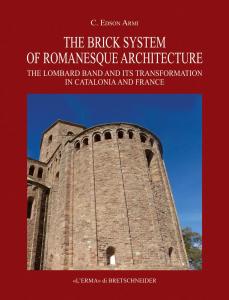The Brick System of Romanesque Architecture The Lombard Band and Its Transformation in Catalonia and France
CODICE: ISBN 8891312533 EAN 9788891312532
AUTORE/CURATORE/ARTISTA :
Author: Clement Edson Armi
EDITORE/PRODUTTORE : L'Erma di Bretschneider
COLLANA/SERIE : Bibliotheca Archaeologica, 56
DISPONIBILITA': Disponibile
TITOLO/DENOMINAZIONE:
The Brick System of Romanesque Architecture The Lombard Band and Its Transformation in Catalonia and France
PREZZO : EUR 100,00€
CODICE :
ISBN 8891312533
EAN 9788891312532
AUTORE/CURATORE/ARTISTA :
Author: Clement Edson Armi
EDITORE/PRODUTTORE:
L'Erma di Bretschneider
COLLANA/SERIE:
Bibliotheca Archaeologica, 56
ANNO:
2017
DISPONIBILITA':
Disponibile
CARATTERISTICHE TECNICHE:
130 pages
8 b&w illustrations, 150 color illustrations
Hardback
cm 21,5 x 28
DESCRIZIONE:
Publisher's description:
At the beginning of the eleventh century in northwestern Italy builders created a comprehensive system of architecture, integrating the square edges of stacked bricks on the exterior with arches, vaults, and niches inside the wall. They used the continuous verticality of bands to plan and demarcate at ground level the placement and spacing of these dynamic structures intended to provide crucial support higher up the elevation. Throughout southern Europe builders copied this system, combining brick-based construction, dynamic and static support, and an endless aesthetic based on continuous square-edged reveals. Experienced Lombard workers, at least initially, would have been needed to explain and implement this complex and holistic approach to architecture.
In major abbeys in Catalonia builders carefully followed the original Lombard system and also imaginatively enriched it, creating a new type of interior, different from the early Christian model (with a wooden ceiling, tall intermediate wall, and flat elevation) perpetuated in the central vessel of contemporary Italian churches. They coupled bands directly to transverse arches beneath barrel vaults and expanded the shape of bands from narrow strips to wide planes as part of a series of projecting wall layers. They also raised the arcade and compressed the intermediate wall, producing a spacious and luminous nave with narrow, high and open side aisles. In major churches in southern France successive generations incorporated many of these changes to the brick-based model and added significantly to them. Seen in this new light, early eleventh-century architecture in Lombardy and Catalonia belies its longstanding reputation as a superficially decorated, pendulously massive, unprogressively folkloric, and largely irrelevant First Romanesque prelude to High Romanesque architecture.
Contents:
PREMESSA, Saverio Lomartire
INTRODUCTION
CHAPTER 1
EARLY CHRISTIAN ARCHITECTURE IN RAVENNA AND MILAN
CHAPTER 2
EARLY ELEVENTH-CENTURY ARCHITECTURE IN LOMBARDY AND THE PIEDMONT
Construction
Structure
Design
CHAPTER 3
CATALONIA: EXTERIOR BANDS AND THE BRICK-BASED SYSTEM
Experiments in stone
CHAPTER 4
CATALONIA: INTERIOR BANDS AND THE BRICK-BASED SYSTEM
CHAPTER 5
THE IMPACT OF CATALAN ARCHITECTURE IN SOUTHERN FRANCE
Hérault
Mconnais
Cluny
CONCLUSION
BIBLIOGRAPHY
GENERE: Libri ,Saggi ,



